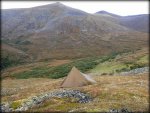I live and hunt in Utah, which is a very arid region compared to pretty much anywhere else in the states, so I do not have experience in torrential downpours lasting all day, but I have been in a few all day drizzles and some snow storms. for the most part only the outer few inches will get water coming under, but everywhere else stays dry especially if you're running a stove (you should; they're great for getting stormed in). You do need to pick a good location for setting up and they're not nearly as "idiot proof" to set up as say a dome tent, so practice a few times before you head out. I don't have a nest, but I'd imagine as long as the bottom is sealed up and relatively water proof it would be very similar to a tent.
A few things I really like about the floorless, is the ability to stand up while getting dressed, not really worrying about tracking stuff in, lighting a fire while in my sleeping bag at 4:30 am and snooze for another 30 before getting out of bed, you can have a small stool in them, if you REALLY need to pee and you don't want to go outside, you have other options (never done that, but options are good). The condensation thing sort of sucks, but it really only affects the outer edges, so just plan accordingly and it's not that big of a deal.
Some situations I have not run into, but think would really suck with a floorless is in a really buggy environment, areas with lots of mice and things of that nature. the nest would resolve most of those though.

